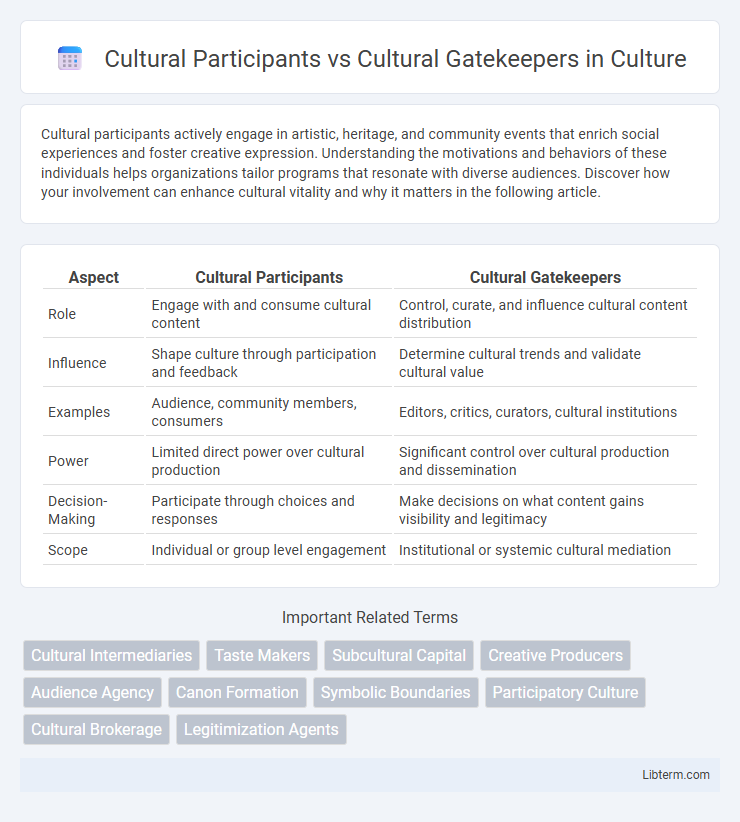Cultural participants actively engage in artistic, heritage, and community events that enrich social experiences and foster creative expression. Understanding the motivations and behaviors of these individuals helps organizations tailor programs that resonate with diverse audiences. Discover how your involvement can enhance cultural vitality and why it matters in the following article.
Table of Comparison
| Aspect | Cultural Participants | Cultural Gatekeepers |
|---|---|---|
| Role | Engage with and consume cultural content | Control, curate, and influence cultural content distribution |
| Influence | Shape culture through participation and feedback | Determine cultural trends and validate cultural value |
| Examples | Audience, community members, consumers | Editors, critics, curators, cultural institutions |
| Power | Limited direct power over cultural production | Significant control over cultural production and dissemination |
| Decision-Making | Participate through choices and responses | Make decisions on what content gains visibility and legitimacy |
| Scope | Individual or group level engagement | Institutional or systemic cultural mediation |
Defining Cultural Participants and Gatekeepers
Cultural participants are individuals who actively engage with, consume, and contribute to cultural expressions such as art, music, and traditions, shaping cultural experiences through their interactions. Cultural gatekeepers, on the other hand, hold influential roles in selecting, interpreting, and controlling the dissemination of cultural content, often determining which cultural forms gain visibility and acceptance. Understanding the dynamics between participants and gatekeepers reveals how cultural narratives are maintained, challenged, or transformed within societies.
Historical Evolution of Cultural Roles
Cultural participants actively engage in the creation and consumption of cultural expressions, shaping societal values over time, while cultural gatekeepers control access to cultural resources, influencing what is preserved and promoted. Historically, roles have evolved from rigid hierarchies where gatekeepers like clergy and aristocrats dictated cultural norms, to more democratized participation facilitated by technology and globalization. This shift reflects changing power dynamics in culture, as digital platforms enable wider participation and challenge traditional gatekeeping structures.
Key Characteristics of Cultural Participants
Cultural Participants actively engage in cultural experiences by consuming, creating, and sharing artistic expressions, often influencing trends through their behavior and preferences. They exhibit high cultural capital, demonstrating familiarity with diverse cultural forms and the ability to interpret and appreciate symbolic meanings. Their participation drives cultural continuity and innovation, making them vital for the dynamic evolution of cultural landscapes.
The Influence of Cultural Gatekeepers
Cultural gatekeepers play a crucial role in shaping cultural landscapes by controlling what content reaches the public, influencing trends in art, media, and entertainment. Their decisions determine which cultural participants gain visibility and legitimacy, often dictating the success or failure of new ideas and expressions. By acting as intermediaries, cultural gatekeepers impact societal values and collective memory, reinforcing dominant narratives while potentially marginalizing alternative voices.
Dynamics of Power in Cultural Spaces
Cultural participants actively engage with, consume, and contribute to cultural content, shaping trends and public discourse through their collective influence. Cultural gatekeepers, such as curators, editors, and producers, control access and visibility of cultural products, wielding significant power to define what is considered legitimate or valuable in cultural spaces. The dynamics of power between these groups reflect ongoing tensions over representation, inclusion, and authority in shaping cultural narratives and identities.
Gatekeeping in the Digital Age
Cultural gatekeepers control the flow of information and influence access to cultural content through digital platforms, shaping public perception and trends. Algorithms and platform policies have amplified their gatekeeping power, filtering and curating content based on engagement metrics and platform guidelines. This digital gatekeeping impacts the visibility of cultural participants by privileging certain voices while marginalizing others in online spaces.
Participation vs. Curation: Shaping Cultural Narratives
Cultural participants actively engage in creating and experiencing cultural expressions, influencing the evolution of narratives through direct involvement and shared practices. Cultural gatekeepers, including curators, critics, and institutions, selectively filter and present cultural content, shaping public perception and preserving dominant narratives. This dynamic between participation and curation plays a critical role in determining which cultural stories gain visibility and resonance within society.
Inclusion, Exclusion, and Cultural Accessibility
Cultural participants actively engage in arts and cultural experiences, directly influencing inclusion by representing diverse voices and broadening accessibility through their involvement. Cultural gatekeepers control access to cultural resources and narratives, often shaping which groups are included or excluded based on institutional power and biases. Understanding the dynamic between participants and gatekeepers is essential for addressing systemic barriers and promoting equitable cultural accessibility.
Case Studies: Impact on Arts and Media
Case studies reveal that cultural participants actively engage in creating and consuming arts and media, driving trends through grassroots innovation and community interaction. Cultural gatekeepers, such as curators and editors, influence public access and interpretation by selecting which works reach broader audiences, thereby shaping cultural narratives. The dynamic interplay between these groups determines the diversity and representation of voices within arts and media industries, affecting cultural evolution and societal values.
Future Trends in Cultural Participation and Gatekeeping
Cultural participants increasingly engage through digital platforms, expanding diverse and globalized content consumption and creation. Cultural gatekeepers are evolving by leveraging AI-driven algorithms and data analytics to curate and influence cultural narratives more dynamically. Future trends indicate a decentralization of gatekeeping roles, with community-driven platforms empowering participants to shape cultural landscapes collaboratively.
Cultural Participants Infographic

 libterm.com
libterm.com